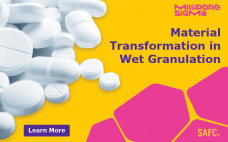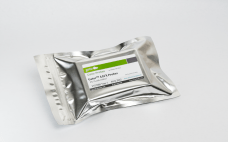Changes in production scale required due to increasing product needs throughout clinical trials introduces risk to the product development timeline. Both the process and the product can be dramatically impacted from scaling-up to larger production volumes due to changes in the bioreactor microenvironment. By “scaling-out,” instead of “scaling-up” these risks can be mitigated. The “scale-out” biomanufacturing paradigm, which involves simply adding one or more of the same-sized bioreactor to the manufacturing run to obtain the production volume required, can also…
Sponsored Content
Material Transformation in Wet Granulation – The Effect of Continuous Process Dynamics, Material and Formulation Properties
Continuous manufacturing (CM) is increasingly used as an alternative to traditional batch manufacturing of solid pharmaceutical dosage forms. Wet granulation is one of the manufacturing technologies that was successfully migrated from batch to continuous processing. Thereby, the residence time of material under (stress) conditions is significantly reduced which in many cases is a main advantage of CM. However, in other cases with slow transformation processes this raises new challenges. In particular, the question arises as to which process parameters and…
Increasing Productivity of IVT Reaction Using At-Line Monitoring by HPLC Chromatography
This webcast features: Rok Sekirnik, PhD, Head of Process Development mRNA/pDNA, BIA Separations, now a Sartorius company. In Vitro Transcription (IVT) reactions are normally performed as batch processes. Considering their catalytic basis, it is possible to extend reaction times and yields by continuous addition of consumed reagents to the reaction mixture. However, fed-batch strategies reported to date have only managed to achieve a 40 – 100% increase in the production of mRNA. One of the main limitations of development has…
Improve Your Cell Line Development Workflows with Analytical Tools
This webcast features: Dirk MĂĽller, PhD, Manager of Media & Process Development, Sartorius, Lukas Klein, Scientist, Sartorius. Cell line development involves screening thousands of clones to find those that are stable, produce high yields of the bioproduct, and exhibit desired critical quality attributes (CQAs). While there are multiple CQAs that need to be monitored early in the development process, product yield, cell count and viability assessment remain the main attributes by which process conditions are optimized. Incorporating analytical techniques into…
CMC Testing Support for Gene and Cell Therapy
With the promise to enhance treatment, greatly reduce side effects, and potentially cure many types of diseases and disorders, Advanced Therapy Medicinal Products (ATMP), such as gene and cell therapy products, are in high demand, and biopharma companies are in a race to the clinic. However, these technologies are very complex in nature and are vastly different than traditional biopharmaceutical products, especially when it comes to the use of these products for personalized medicine. The complexities span the development pipeline,…
3M™ Harvest RC Chromatographic Clarifier Beta Testing Series Summary
Frost & Sullivan invited a panel of industry leaders and key opinion leaders in pharmaceutical bioprocessing to participate in a new and unique thought leadership forum, our Virtual Think Tank (VTT) Early Access series. Each VTT panel, comprising professionals from pharmaceutical companies, contract development and manufacturing organizations (CDMOs), and 3M Company, discussed the new 3M™ Harvest RC Chromatographic clarification technology following participation in a beta test program that allowed them early access to work with the product and provide hands-on…
Comparison of Gator BLI and Progen ELISA for Quantitation of AAV Serotypes
The determination of total capsid titer is one of the critical quality attributes for AAVs used in gene therapy. This application note presents quantitation of AAV serotype 2, 5, 8 and 9 using GatorPrime™ system and Gator™ AAVX probes, and compares the performance with Progen Xpress ELISA assay for the same serotypes. The Progen ELISA kit is commonly used for AAV quantitation and while it performs well, it has several drawbacks for routine operation, viz, need to dilute the samples…
Viral Clearance: A WuXi Advanced Therapies Perspective
This webcast features: Kathleen Kenney, Associate Director, Viral Clearance, WuXi Advanced Therapies, R. Christopher Manzari, Manager, Viral Clearance – DSP/Virus Production, WuXi Advanced Therapies. Join us for a discussion on the risk-based approach in the development of Viral Validation studies, a key testing requirement for regulatory submissions of viral vector-based therapeutics, at WuXi Advanced Therapies. In this webinar, members of the Viral Clearance Management team will cover the basics of viral clearance, study development and the general timeline. Collaboration between…
Promoter Discovery for Optimized Viral Vector Development
This webcast features: David W. Brighty, PhD, Head of Bioprocessing Research at OXGENE, WuXi Advanced Therapies. A primary determinant of gene expression is invariably the activity of the promoter upstream of the regulated gene. Viral vectors used to deliver a therapeutic transgene into target cells to treat disease are no exception. For viral vectors, the promoters used to drive transgene expression are typically constitutively active, often display little tissue-specificity, and frequently fail to express the therapeutic transgene at optimum physiological…
Addressing Purification Challenges for Complex Therapeutics with Custom Chromatography Resins
This webcast features: Laurens Sierkstra, Business Segment Leader, Bioproduction Group, Thermo Fisher Scientific. Ongoing progress in biotherapeutics development has initiated an increasing range of complex molecules entering the drug development pipeline such as novel vaccines and therapeutic proteins. This often rises challenges in the manufacturing process of these newer modalities, with downstream operations as a focus point as this part of the production process frequently represents a bottleneck. Addressing downstream challenges requires novel purification strategies for commercial manufacturing which may…










